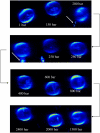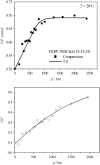Pressure tuning of the morphology of heterogeneous lipid vesicles: a two-photon-excitation fluorescence microscopy study
- PMID: 16877511
- PMCID: PMC1578477
- DOI: 10.1529/biophysj.106.088716
Pressure tuning of the morphology of heterogeneous lipid vesicles: a two-photon-excitation fluorescence microscopy study
Abstract
We used a technique that allows us to visualize local and morphological changes of the membrane of more component giant unilamellar vesicles due to high pressure perturbation. Under these conditions, thermally induced processes are largely suppressed, and the bending rigidity and line tension are influenced by pressure-induced changes in lipid molecular packing and shape only. We studied the effect of pressure on the lateral organization and morphology of the model raft system DOPC (1,2-dioleoyl-sn-glycero-3-phosphocholine)/sphingomyelin/cholesterol as well as of the fluid mixture POPC (1-palmitoyl-2-oleoyl-sn-glycero-3-phosphocholine)/DLPC (1,2-dilauroyl-sn-glycero-3-phosphocholine) by two-photon excitation fluorescence microscopy. The pressure-dependent experiments were carried out using a sample cell made from a thin fused silica capillary. The use of Laurdan as fluorescence label allowed us to also follow the lipid phase state by calculating the generalized polarization (GP) values of the vesicles and extracting their average value. During the compression cycle, a reduction in the volume of the vesicles is observed, accompanied by an increase of the average GP value, indicating an increasingly tighter packing of the lipids. Interestingly, the two systems studied show phenomena of budding and fission, and these at surprisingly low pressures of 200-300 bar. Moreover, these budding processes are not directly related to phase transitions to an overall ordered conformational state of the lipid membrane, which occur at much higher pressures. The topological changes of the lipid vesicles are irreversible and exhibit a different behavior depending on whether the pressure is increased or decreased. The results are discussed in light of the various contributions to the free energy functional of lipid vesicles. Finally, the biological relevance of these studies is highlighted.
Figures




Similar articles
-
A correlation between lipid domain shape and binary phospholipid mixture composition in free standing bilayers: A two-photon fluorescence microscopy study.Biophys J. 2000 Jul;79(1):434-47. doi: 10.1016/S0006-3495(00)76305-3. Biophys J. 2000. PMID: 10866969 Free PMC article.
-
Two photon fluorescence microscopy of coexisting lipid domains in giant unilamellar vesicles of binary phospholipid mixtures.Biophys J. 2000 Jan;78(1):290-305. doi: 10.1016/S0006-3495(00)76592-1. Biophys J. 2000. PMID: 10620293 Free PMC article.
-
A two-photon view of an enzyme at work: Crotalus atrox venom PLA2 interaction with single-lipid and mixed-lipid giant unilamellar vesicles.Biophys J. 2002 Apr;82(4):2232-43. doi: 10.1016/S0006-3495(02)75569-0. Biophys J. 2002. PMID: 11916878 Free PMC article.
-
Fluorescent probe partitioning in giant unilamellar vesicles of 'lipid raft' mixtures.Biochem J. 2010 Sep 15;430(3):415-23. doi: 10.1042/BJ20100516. Biochem J. 2010. PMID: 20642452
-
Phase diagram of a 4-component lipid mixture: DSPC/DOPC/POPC/chol.Biochim Biophys Acta. 2013 Sep;1828(9):2204-14. doi: 10.1016/j.bbamem.2013.05.020. Epub 2013 Jun 7. Biochim Biophys Acta. 2013. PMID: 23747294 Free PMC article.
Cited by
-
Quantitative High-Resolution Imaging of Live Microbial Cells at High Hydrostatic Pressure.Biophys J. 2020 Jun 2;118(11):2670-2679. doi: 10.1016/j.bpj.2020.04.017. Epub 2020 Apr 23. Biophys J. 2020. PMID: 32402241 Free PMC article.
-
Pressure effects on lipids and bio-membrane assemblies.IUCrJ. 2014 Sep 23;1(Pt 6):470-7. doi: 10.1107/S2052252514019551. eCollection 2014 Nov 1. IUCrJ. 2014. PMID: 25485127 Free PMC article. Review.
-
LAURDAN since Weber: The Quest for Visualizing Membrane Heterogeneity.Acc Chem Res. 2021 Feb 16;54(4):976-987. doi: 10.1021/acs.accounts.0c00687. Epub 2021 Jan 29. Acc Chem Res. 2021. PMID: 33513300 Free PMC article.
-
Observations of Membrane Domain Reorganization in Mechanically Compressed Artificial Cells.Chembiochem. 2019 Oct 15;20(20):2666-2673. doi: 10.1002/cbic.201900167. Epub 2019 Oct 1. Chembiochem. 2019. PMID: 31087814 Free PMC article.
-
Monitoring biophysical properties of lipid membranes by environment-sensitive fluorescent probes.Biophys J. 2009 May 6;96(9):3461-70. doi: 10.1016/j.bpj.2009.02.012. Biophys J. 2009. PMID: 19413953 Free PMC article. Review.
References
-
- Winter, R., editor. 2003. Advances in High Pressure Bioscience and Biotechnology II. Springer-Verlag, Heidelberg, Germany.
-
- Balny, C., R. Hayashi, K. Heremans, and P. Masson, editors. 1992. High Pressure and Biotechnology. Colleque Inserm, Vol. 224. John Libbey Eurotext, Montrouge, France.
-
- Balny, C., P. Masson, and K. Heremans. 2002. High pressure effects on biological macromolecules: from structural changes to alteration of cellular processes. Biochim. Biophys. Acta. 1595:3–10. - PubMed
-
- Ludwig, H. editor. 1999. Advances in High Pressure Bioscience and Biotechnology. Springer-Verlag, Heidelberg, Germany.
-
- Winter, R., and W. Dzwolak. 2004. Temperature-pressure configurational landscape of lipid bilayers and proteins. Cell. Mol. Biol. 50:397–417. - PubMed

